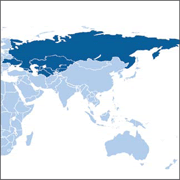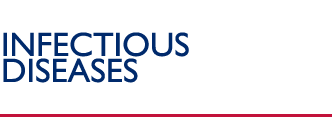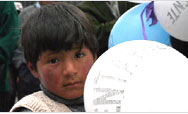Europe And Eurasia

|
|
USAID provides support for TB control and prevention in nine countries (Russia, the five Central Asia Republics, Ukraine, Georgia, and Azerbaijan), which are among those with the highest burden of tuberculosis (TB) in the Europe and Eurasia (E&E) region. USAID provides technical assistance and support to the World Health Organization's (WHO's) European Regional Office for TB control activities. These nine countries accounted for two-thirds of all cases in the European Region in 2006. Forty-five percent of the new cases in 2006 were sputum-smear positive (SS+). Russia, with close to 153,000 new cases, has the highest number of new cases; however, Tajikistan has the highest incidence rate, at 204 cases per 100,000 population, in the WHO European Region. Incidence may be declining in Georgia, Kazakhstan, Kyrgyzstan, Russia, and Turkmenistan, but it has increased by 3.4 percent in Uzbekistan, by 4.2 percent in Ukraine, and by 5.8 percent in Tajikistan. Treatment default and failure rates among new patients are higher in several E&E countries than the average rate for WHO high-burden TB countries (HBC). Default under DOTS in HBC averages 5 percent, failure averages 1.6 percent and death, 4.1 percent. Among the TB focus countries in the E&E region, default ranges from 3 to 13 percent, failure ranges from 4 to 14 percent, and death ranges from 3 to 13 percent. Trend data on TB case fatality rates show that it has not substantially declined in these countries over the past 10 years. Although Georgia has made some progress, the average case fatality rate among the focus countries has increased from 11.2 to 16.8 per 100,000 population, and the average annual number of TB deaths in these countries have increased from 3,787 to 4,846 deaths. This is mostly due to treatment interruption, drug resistance, and weak health systems.
All countries are now implementing WHO’s DOTS (directly observed treatment, short course) strategy. Treatment success rates have improved in several countries over the past four years but have declined sharply in Russia, Kazakhstan, and Azerbaijan, which in part may be due to the rise in drug-resistant TB. Case detection has steadily improved in all countries, except in Kazakhstan and Azerbaijan. Azerbaijan has struggled to reform and maintain the health system since the collapse of the Soviet Union, and there have been issues with determining case detection and treatment under DOTS. Between 2002 and 2006, case detection in Azerbaijan fell from 80 to 50 percent.
Multidrug-resistant (MDR) TB and extensively drug-resistant (XDR) TB rates have soared throughout the region over the past decade. This has created greater demands on health services, especially laboratory diagnosis as well as financing and delivery of TB treatment with second-line drugs. Together, the nine E&E countries accounted for 14 percent of the global burden of MDR-TB in 2008.
TB-HIV/AIDS co-infection rates are low in most E&E countries, although they range from 0.3 and 0.4 percent in Georgia and Kyrgyzstan, respectively, to much higher rates ranging from 3.8 and 8.0 percent in Russia and Ukraine, respectively.1
Ukraine has the largest number of co-infected cases in Europe, and the WHO estimate may underestimate the true co-infection rate. Data from a survey conducted in the first half of 2006 in the Donetsk Oblast show the co-infection rate to be 15.5 percent among civilians, and as high as 23.7 percent in the penitentiary system. Addressing gaps in services for most-at-risk populations is important to reduce the risk of co-infection and MDR-TB.
USAID Approach and Key
Activities
The E&E regional activities focus on increasing political commitment and human resources capacity for TB control. USAID support has focused on training health professionals, integrating TB services into primary heath care (PHC) programs, improving the knowledge and skills of providers and clients, and fostering collaboration and coordination between the National TB Control Programs (NTCPs) and international partners. USAID supports the following activities in the region:
- Strengthening and expanding quality DOTS services
- Developing and revising national- and district-level policies to meet international standards for TB prevention, care, and treatment
- Training health professionals to improve case detection of TB and adherence to the DOTS regimen and reduce the risk of MDR-TB and XDR-TB
- Improving access to testing and treatment among high-risk populations
- Improving and supporting the integration of TB services into the PHC setting, critical to the prevention and control of TB in all countries
- Increasing civil society involvement in TB control efforts
- Supporting the U.S. CDC to develop and strengthen surveillance of MDR-TB
- Supporting efforts to improve government policies in order to ensure the uninterrupted supply of quality TB pharmaceuticals at reduced prices
- Participating in and providing technical assistance (TA) to National TB Working Groups and Country Coordinating Mechanisms
USAID Program Achievements
USAID support has contributed to the following achievements:
- Developed recommendations and a plan of action to implement the WHO strategy on the Practical Approach to Lung Health in order to strengthen the overall management of respiratory diseases at the PHC level
- Provided TA to Georgia and to five regions in Russia, which enabled their successful application to WHO’s Green Light Committee for second-line drugs to fight MDR-TB
- Provided TA to Kazakhstan and Georgia to enable the successful application to the Global Fund to Fight AIDS, Tuberculosis and Malaria; and provided TA to Georgia, Turkmenistan, and Kazakhstan to enable the successful application to the Global TB Drug Facility to receive pediatric doses of TB drugs
- Piloted a logistics management information system (LMIS) project in Kazakhstan, Kyrgyzstan, and Uzbekistan and trained TB staff on it, ensuring that Kazakhstan will implement the LMIS nationwide
- Facilitated the integration of DOTS into all levels of medical education in Kazakhstan and Turkmenistan
- Financed the expansion of DOTS to reach a total of 90 percent of the population in Turkmenistan and delivered 10 microscopes and other laboratory materials to government health centers
- Facilitated the integration of DOTS services into the primary health care level, insuring direct observation of treatment in Georgia and Armenia
- Provided TA to implement and expand a computer-based TB Electronic Surveillance and Case Management (ESCM) system in Kyrgyzstan, Kazakhstan, and Uzbekistan, which provides decisionmakers with key data to make informed decisions about TB policy
- Opened a new Center of Excellence in Orel, Russia, which will serve as a national training center
- Trained all health staff (TB and general practitioners) to provide high-quality DOTS, covering the eight largest oblasts in Ukraine
- Completed a groundbreaking study of 258 TB treatment defaulters in Uzbekistan, which was commissioned by the national DOTS center, with the results to be used to improve Uzbekistan’s treatment success rate
- Supported the TB laboratory in the Khakasia Republic of Russia to attain the highest proficiency in TB testing nationwide
- Improved the quality of seven regional laboratories in Russia to approach U.S. CDC standards
- Enabled WHO to provide training on MDR-TB activities to 18 national TB program managers and to print and distribute WHO’s Guidelines for the Programmatic Management of Drug Resistant Tuberculosis
- Established the Russian-English TB Web site to provide TB educational materials specific to the region and to educate communities about TB-HIV/AIDS co-infection and MDR-TB, resulting in more than 50,000 people from 54 different countries/territories visiting the forum on MDR-TB
- Established the Virtual Leadership Development Program to addresses TB-HIV/AIDS co-infection by strengthening the national leadership capacity’s ability to address the challenges in TB and HIV/AIDS program coordination
Partnerships
USAID is the leading donor supporting DOTS implementation in these countries. USAID’s partners include the national governments and Ministries of Health, NTCPs, WHO, the U.S. CDC, Project HOPE, The Capacity Project, and PATH. The Global Fund has provided a total of $190.6 million to Azerbaijan, Georgia, Kazakhstan, Kyrgyzstan, Russia, Tajikistan, and Uzbekistan during Rounds 2 through 8.
1 Source: WHO 2007 data, as reported by USAID
February 2009
Related Links
|


